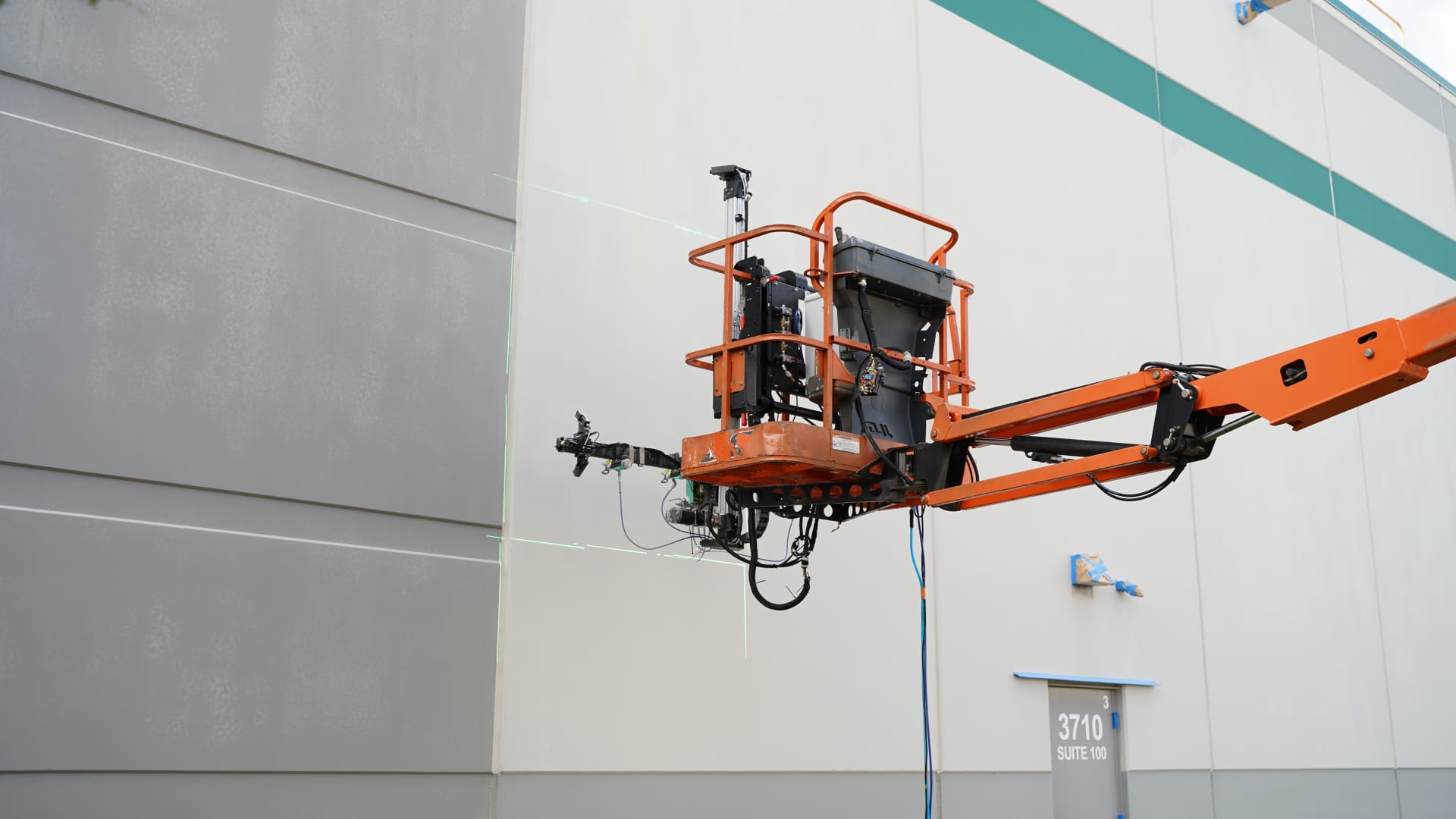With just 20 employees and a fleet of remote-controlled robots, a startup called PaintJet has managed to cover more than 1.5 million square feet of building exteriors and ships in less than three years.
The startup, based in Hendersonville, Tennessee, is the brainchild of CEO Nick Hegeman along with cofounders Steve Wasilowski and Sonia Chacko. They started the company after Hegeman drew inspiration from his first foray into business ownership: Running a CertaPro Painters franchise in greater Nashville.
Hegeman tells CNBC, “With painting, the labor shortage hits you right in the face. It was not so much a challenge to sell and book work, but it was always a challenge to do the work. At one point, we were painting a 150,000 square foot warehouse and I had to let go of a crew – it’s not ideal, but it happens. Then it was just myself and my wife painting a huge warehouse just to meet a customer deadline.”
Before the soreness from their exertion had even worn off, Hegeman, who is a mechanical engineer by training, began dreaming up systems that could meet the demands of a growing market for painting services as labor remained in tight supply.
Rather than engineering a complex humanoid robot to paint like a person, or some kind of autonomous wall crawler, PaintJet focused on pragmatic engineering. The team studied equipment that was already proven safe and widely used on jobs that are generally challenging to staff, such as painting the exterior of warehouses and data centers.
The company’s eventual solution was to build modular robotics that are attached to a lift, or “cherry picker,” like the ones commonly used to hoist construction workers up to work high up on large buildings.
The PaintJet system is affixed to the basket of the lift as an “end effector” and includes cameras that scan the surface of a building, one 50-square-foot box at a time. After the area has been scanned, sprayer jets glide over, painting box by box until the job is complete. PaintJet operators on the ground use a remote control to operate both the lift and the end effectors.
Instead of selling or renting its robots out to construction crews, the startup offers an end-to-end service and maintains control of the entire painting process. PaintJet can use any commercially available paint in its machines, but also makes and sells its own line of paints.
One of the startup’s objectives is to help customers use as little paint as possible to get a job done, says Hegeman. “Paint can be expensive when you’re using so much of it, and a lot of paints contain toxic chemicals that nobody wants to touch,” the CEO explained. The company’s precise application results in around 25% less paint being used than in a traditional application, he said.
Exterior paints typically include volatile compounds that make paint glide onto a surface more easily, stick there even through bad weather, and prevent rust, corrosion, or fungus and algae growth. Large ships, which PaintJet can also cover, need to include anti-fouling agents that also block mollusks from attaching themselves to the bottom of a boat. “The state of how smooth the bottom of the boat is really matters– if that starts getting rough you can lose 40% of your fuel economy on a ship,” Hegeman said.
Besides helping ships ensure fuel efficiency, commercial buildings — such as warehouses and data centers– can use paint with insulating properties to save on heating and cooling costs. PaintJet says its customers can see 9% savings in HVAC-related energy costs after they re-paint.
New paints could make those savings even greater. SRI International, for example, has developed what it calls a “Self Cooling Paint,” that can cool the temperature of any surface down about 18 degrees (or 10 degrees Celsius) lower than the ambient air temperature.
While PaintJet’s early customers have included construction companies and real estate developers, the startup is aiming to expand rapidly within exterior painting, which it sees as a quarter-trillion dollar industry. That means building and deploying more of its robot painters, and doubling or tripling headcount over the next year, Hegeman says.
PaintJet, which is incorporated as Foreman Technologies, has raised grant funding from 757 Accelerate in Virginia, and early stage venture funding from Metaprop in New York, Dynamo Ventures in Chattanooga, and Pathbreaker, a San Francisco venture fund focused on robotics.
Pathbreaker’s founder and managing partner Ryan Gembala says PaintJet could potentially benefit from a number of climate and infrastructure focused bills and programs in the US. But he invested in PaintJet well before initiatives like the Inflation Reduction Act.
“It was just fundamental business strength,” the investor said. “PaintJet is tapping into this $200 billion plus paint market. And paint is everywhere! But the way it’s done today — it’s a service businesses where the employees are leaving. It’s just a very tough industry to maintain personnel-wise. This company has a novel tech approach that’s hard to replicate and they’re already exceeding customer expectations.”
Hegeman said the company is also developing capabilities to handle more tasks in construction and maintenance with robotics including pressure washing, caulking and sanding.

